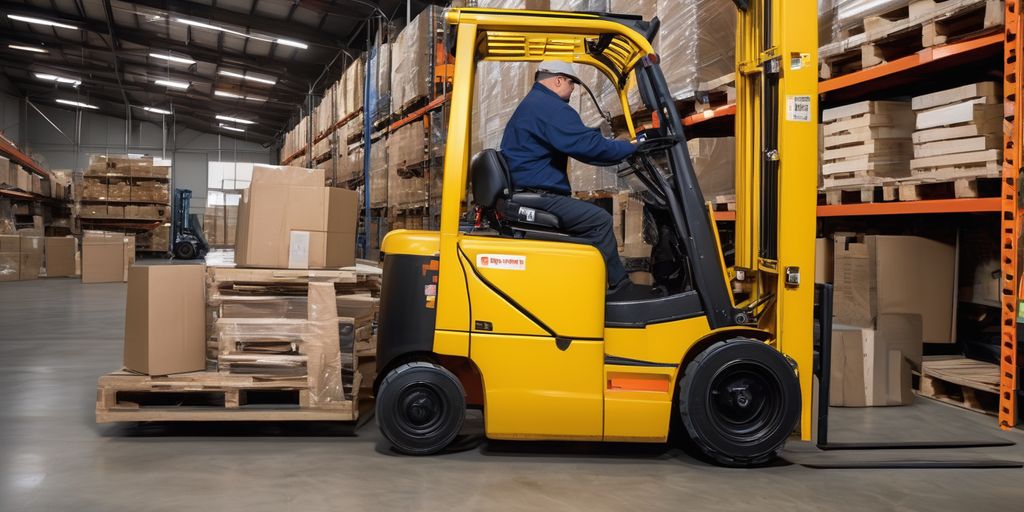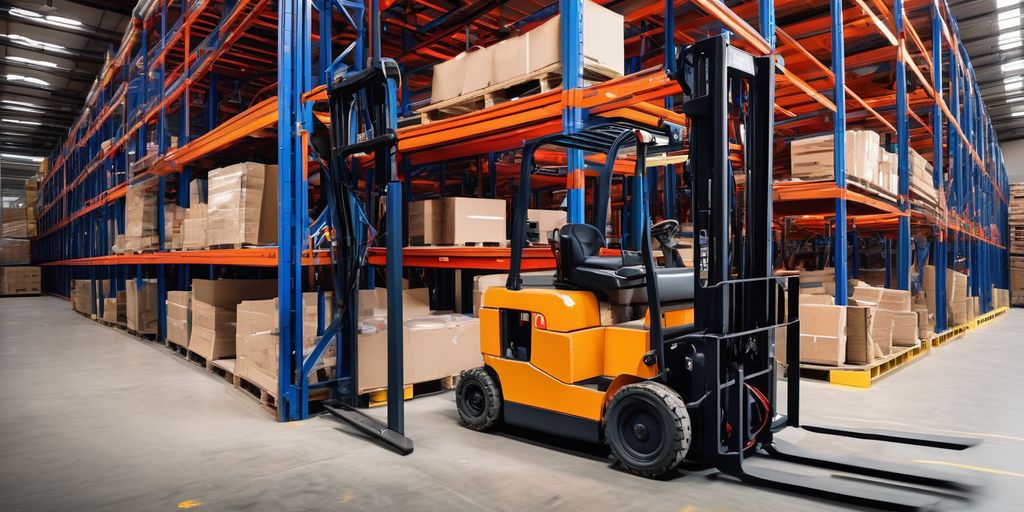Forklifts are indispensable tools in various industries, from warehouses to construction sites, due to their ability to move heavy loads efficiently. However, to ensure safety and compliance, it's crucial to follow OSHA regulations for forklift operations. This article delves into the key OSHA forklift safety standards, equipment requirements, fuel handling guidelines, training and certification requirements, and more.
Key Takeaways
- Understanding and complying with OSHA forklift regulations is essential to maintain a safe workplace and avoid penalties.
- Key safety features for forklifts include overhead guards and vertical load backrest extensions, which are mandatory under certain conditions.
- Proper fuel handling and storage, in accordance with NFPA guidelines, is crucial to prevent accidents and ensure safety.
- Regular training and certification for forklift operators are mandatory to ensure they are equipped with the necessary skills and knowledge.
- Daily inspections and maintenance of forklifts are vital to identify and address potential issues before they lead to accidents.
Key OSHA Forklift Safety Standards

Overview of OSHA Forklift Standards
The Occupational Safety and Health Administration (OSHA) sets the standards for forklift safety to ensure the well-being of operators and other employees. Employers that comply with OSHA standards can lower the risk of forklift accidents. These standards cover various aspects of forklift operations, including equipment requirements, operational practices, and training protocols.
Importance of Compliance
Compliance with OSHA forklift safety standards is crucial for maintaining a safe work environment. Non-compliance can lead to severe consequences, including accidents, injuries, and legal penalties. Employers must ensure that all forklift operators are properly trained and certified to meet OSHA requirements.
Following OSHA forklift safety rules — you’ll be glad you did. Employers that comply with OSHA standards can lower the risk of forklift accidents. They can also help their forklift operators safely and effectively perform everyday tasks.
Common Violations and Penalties
Common violations of OSHA forklift safety standards include lack of proper training, failure to perform regular equipment inspections, and improper handling of loads. These violations can result in significant penalties, including fines and operational shutdowns. Below is a table summarizing some common violations and their associated penalties:
| Violation | Penalty |
|---|---|
| Lack of Training | Up to $13,653 per violation |
| Failure to Inspect Equipment | Up to $13,653 per violation |
| Improper Load Handling | Up to $13,653 per violation |
5 important forklift safety tips:
- Train for safety with proper instruction.
- Perform regular checkups.
- Understand forklift machinery and rules.
- Know load basics for safe transport.
- Follow OSHA guidelines for safe operations.
Safety Guards and Equipment Requirements

Overhead Guards
High lift rider trucks must have an overhead guard that complies with ANSI guidelines for powered forklifts. These guards are essential to protect operators from falling objects and other overhead hazards.
Vertical Load Backrest Extensions
If there are any hazards associated with the load, the truck must have a vertical load backrest extension. This extension helps in preventing the load from falling backward onto the operator, ensuring maximum safety during operations.
Additional Safety Features
To enhance safety, forklifts may be equipped with additional features such as:
- Guardrails
- Bollards
- Curb barriers
These solutions create separation between forklifts and pedestrians, reducing the risk of accidents.
Ensuring that all safety guards and equipment are in place and functioning correctly is crucial for maintaining a safe working environment.
Fuel Handling and Storage Guidelines

Proper Storage Procedures
Proper storage of fuels is critical to ensure safety and compliance with OSHA regulations. Gas, diesel fuel, and LPG must be stored in well-ventilated areas away from ignition sources. Containers should be clearly labeled and stored in designated areas to prevent accidents.
Handling Gas, Diesel, and LPG
Handling these fuels requires strict adherence to safety protocols. Use appropriate lifting equipment or carts to move containers, and never drop, roll, or strike them. Always wear protective gear and ensure that all handling is done in well-ventilated areas to avoid the buildup of unsafe gases and fumes.
NFPA Compliance
Compliance with NFPA Flammable and Combustible Liquids Code is mandatory. NFPA 30 warns against storing more than 120 gallons of Class IB, Class IC, Class II, or Class III liquids in containers. Regular inspections and adherence to these guidelines are essential to maintain a safe working environment.
Ensuring proper fuel handling and storage is not just about compliance; it's about creating a safe workplace for everyone.
Battery Changing and Charging Protocols

Designated Charging Areas
Designated battery charging stations must be set up and used at all times. A conveyor or overhead hoist must be used to handle batteries. Recharged truck batteries must be properly stored and maintained. To fully charge a battery, a truck must be completely deactivated. Defective battery vent caps must be replaced. Employees should never smoke in the battery charging area.
Safety Measures During Charging
- Ensure proper ventilation in the charging area.
- Use personal protective equipment (PPE) such as gloves and safety glasses.
- Keep a fire extinguisher nearby.
- Avoid open flames and sparks.
- Regularly inspect charging equipment for damage.
Forklift battery maintenance is crucial for longevity and efficiency. Safety protocols, emergency procedures, and optimal charging practices are key for prolonging battery life and preventing costly replacements.
Maintenance of Batteries
- Regularly check battery water levels and refill as necessary.
- Clean battery terminals to prevent corrosion.
- Inspect batteries for any signs of damage or wear.
- Follow manufacturer guidelines for battery maintenance.
| Maintenance Task | Frequency |
|---|---|
| Check water levels | Weekly |
| Clean terminals | Monthly |
| Inspect for damage | Monthly |
| Full maintenance check | Quarterly |
Articles on maximizing warehouse efficiency, forklift battery maintenance, common maintenance mistakes, and training importance for forklift operations. Enhancing productivity and safety in logistics and warehouses.
Training and Certification Requirements

Mandatory Training Programs
Forklift training and certification are crucial for workplace safety and efficiency. OSHA mandates comprehensive training to minimize risks and enhance operational productivity. Compliance reduces legal liabilities and boosts efficiency.
Certification Process
Forklift operators play a vital role in safe material transportation. Certification ensures competency, compliance with OSHA, and opens career opportunities. Training and passing exams are key steps.
Certified forklift operators must be re-evaluated every 3 years. A record of each operator’s name, date of training and evaluation, and the trainer’s name should be kept on file at a minimum.
Renewal and Continuous Education
OSHA forklift training requirements consist of three main components: the training program itself, the topics taught, and renewal training. If you’re unsure how to become OSHA compliant, keep in mind these three things:
- The training program
- The topics taught
- Renewal training
Comprehensive forklift training and certification is the best way to prevent workplace accidents and stay aligned with OSHA forklift regulations. Most people complete training in about an hour.
Safe Operation Practices

Operating a forklift safely is crucial to prevent accidents and ensure workplace safety. Safety First: Best Practices for Operating a Forklift. Key takeaways include understanding controls, handling loads properly, maintaining clear visibility, and prioritizing pedestrian safety to prevent accidents and ensure workplace safety.
Inspection and Maintenance of Forklifts

Regular forklift maintenance is crucial for safety, preventing accidents and costly repairs. Inspections should include tires, brakes, steering, and fluid levels to ensure proper operation. Daily inspections are mandatory and should be documented using a checklist.
Preventative maintenance checklist for forklifts includes assessing forks, chains, lubrication, battery care, cleaning, and structural integrity checks. Regular maintenance enhances safety and efficiency in industrial settings. Adhering to a scheduled maintenance plan helps in identifying potential issues before they become major problems.
Timely reporting and addressing of issues can prevent accidents and ensure the longevity of the equipment.
Conclusion
Understanding and adhering to OSHA regulations for forklift operations is crucial for maintaining a safe and efficient workplace. These regulations, as outlined in OSHA Forklift Standards, Part 1910, Subpart N, provide comprehensive guidelines on various aspects such as safety guards, fuel handling, vehicle inspection, and operator training. By following these rules, businesses can significantly reduce the risk of accidents and ensure that their forklift operators are well-trained and certified. Compliance not only helps in avoiding penalties but also promotes a culture of safety and responsibility. Ultimately, the goal is to create a work environment where safety is prioritized, and operations run smoothly, benefiting both employers and employees alike.
Frequently Asked Questions
What are the key OSHA forklift safety standards?
The key OSHA forklift safety standards are outlined in OSHA Forklift Standards, Part 1910, Subpart N, titled 'Powered Industrial Trucks.' These standards cover various aspects such as safety guards, fuel handling and storage, battery changing and charging protocols, training and certification requirements, and safe operation practices.
Why is compliance with OSHA forklift regulations important?
Compliance with OSHA forklift regulations is crucial to ensure the safety of forklift operators and other employees in the workplace. It helps in preventing accidents, reducing risks, and avoiding penalties that may arise from non-compliance.
What are the common violations of OSHA forklift regulations?
Common violations include failure to provide proper training and certification for operators, not conducting daily safety checks, improper storage and handling of fuels, and neglecting regular maintenance and inspection of forklifts.
What safety guards are required for forklifts?
High lift rider trucks must have an overhead guard that complies with ANSI guidelines. If there are hazards associated with the load, the truck must also have a vertical load backrest extension to ensure safety.
What are the fuel handling and storage guidelines for forklifts?
Gas, diesel fuel, and LPG must be stored and handled according to NFPA Flammable and Combustible Liquids Code guidelines. Proper storage procedures must be followed to ensure safety and compliance.
What are the training requirements for forklift operators?
All forklift operators must be at least 18 years old and receive proper training and certification. Employers are required to develop and enforce a written program that includes operator training, licensure, and a review/renewal program.




Leave a comment
This site is protected by hCaptcha and the hCaptcha Privacy Policy and Terms of Service apply.